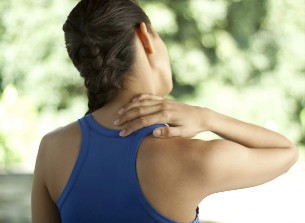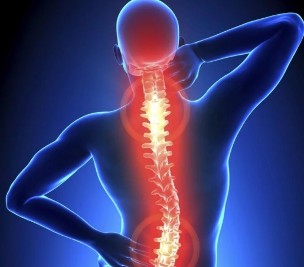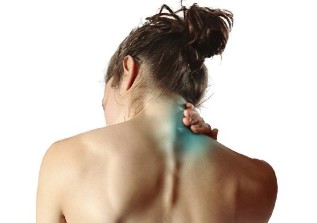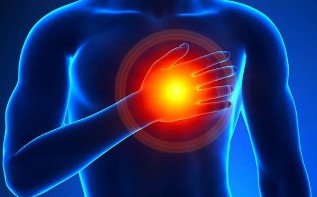The osteochondrosis of the cervical spine is progressive, which represents a specific the change of the intervertebral discs, accompanied by their deformation and the change of the structure.

A cause of the disease. The main cause is the failure of the processes of change in the body and, as a consequence, the deterioration of blood supply to the intervertebral discs. Less frequently the disease occurs as a result of cervical injury the division of the vertebral column. Favor the development of osteochondrosis: lerdo the style of life, a bad posture for a long time "seat" on the desktop in front of the computer, etc
The osteochondrosis of cervical, the treatment in the clinic
The treatment of the degenerative disc disease cervical in the clinic is performed with methods eastern of the medicine. In the process of treatment methods are used for tibetan medicine points massage and herbal medicine, methods of chinese medicine it is, in the first place, acupuncture and moxibustion. It is possible the use of gentle chiropractic therapy osteopathy (including the "cranio-sacred technical", which are a gentle method of exposure to the bones and soft structure of the skull; the purpose of the method - the correct recovery circuit of the cerebrospinal fluid (csf) and other the techniques available to the doctors of the clinic.

The treatment of osteochondrosis of cervical the spine is one of the activities of the clinic. On the basis of in the great experience of work in this sense, we can say that the results of the the treatment of this disease (including complicated protrusions and hernias the spine) quite satisfactory. The treatment of the degenerative disc disease cervical individually for each patient and is carried out exhaustively (in the process of the session usually involves several techniques of treatment, the duration of the session – 1-1,5 hours). Pain in the cervical region, are usually taken up to 70% after 2-3 therapy of the session. Course of treatment of osteochondrosis, on average, is 5 to 11 sessions. During the treatment impact and the pathological changes in the body, leading to the onset of the disease.
Characteristics of degenerative disc disease cervical spine
The osteochondrosis of cervical, in comparison maternal and lumbar the osteochondrosis, has a number of features. These characteristics determine in large both, the features of the structure of the vertebrae in the cervical region, the dimensions of the bone structure which is much smaller than the size of the vertebrae of other departments. Cervical region more a department of the spine, keeping the head, he's always loaded. The osteochondrosis often affects the mobile segments (the loins-5-7) - this determines, in the last instance, the symptoms of degenerative disc disease cervical.
In the area of the neck at the relatively small amount of numerous vascular and nerve of the entities, including here goes vertebral artery that supplies blood to the rear of the departments of the brain - oblong brain and cerebellum. With the compression of the vertebral artery due to the reduction of the circulation of the blood as a result of the stenosis, it is possible the development of ischemia in the brain and the of the spinal cord, and in the acute, can cause spinae a stroke. The symptoms of the defeat of the vertebral artery - dizziness, lack of coordination of movement, impairment of hearing and vision.
Due to the compactness of the cervical region, small the displacement of the vertebrae or stress the muscles can be the cause of nerve compression endings (nerve in the cervical region) or of vascular structures. Form over time osteophytes in terms of compactness of the cervical region aggravate the situation.

Collar of the osteochondrosis leads to the formation of propellant and hernia of the vertebral column, which (in addition to the above causes of muscle tension, the displacement of the cervical vertebrae, the education osteophytes), comprimarea nerve root, cause swelling and inflammation. Finally, taking into account the small dimensions of the vertebral the cervical canal, the ridge occupies the whole volume, in addition compremised (the compression ratio is produced in the spinal canal). The clinical symptoms of this the state - expressed pain syndrome.
The osteochondrosis can be the cause of the the compression of the spinal cord, and due to the narrowness of the spinal canal cervical the spine is increasingly common in the dorsal and lumbar departments. When this in the area of the defeat get not only the neck and head, but of the same above (which is celebrated on the more often) and the lower extremities. Precisely because of its characteristics of osteochondrosis of cervical more often (in comparison with back and breast), leads the patient to disability.
To summarize, let's enumerate the factors that determine the compression of the different vascular and of the nerves of the structures of the osteochondrosis of cervical
- The displacement (slip) of vertebral disc - spondylolisthesis. More often - displacements are minimal, since even a small displacement the vertebrae of the cervical region causes a paralysis, and more often is the cause of death the exodus.
- Propellant and of the hernia the spine as a result of the development of the degenerative disc disease cervical of the spinal column and directed in the interior of the spinal canal.
- The osteophytes. As a result of the degenerative disc disease cervical of the sides the bodies of the vertebrae and in the area of the joints form bone expansion - the osteophytes. Osteophytes, located to the sides of the vertebral bodies, irritate adjacent to them the muscles, the tone that comes up. When this increases pressure on the vertebrae, which leads to an increase of the pressure in the intervertebral disc, the height of your when this decreases, also increases the risk of propellant of the intervertebral disc. Osteophytes directed towards the channel, where it passes vertebral artery may be the cause of the stenosis.
- The reduction of the height of the vertebral disc (flattening of the intervertebral disc)is a frequent cause of compression of roots through the reduction of the the neural foramen. In addition, in this case, the not able to turn the neck is possible subluxation of the cervical vertebrae, which leads to more compression.

Collar of the osteochondrosis symptoms
The symptoms of degenerative disc disease cervical the spine depend, first of all, what became the object of defeat. The following are distinguished: radicular syndromes (compression of spinal roots), the compression of the of the spinal cord, the spinal cord ischemia resulting from stenosis of the vertebral artery, in consequence, alters the blood supply in the brain stem, the cerebellum, cranial the nerves and the inner ear. Listed below are the more common of the syndromes.
- Root syndromes - neck radiculitis. Occur when comprimarea roots (nerve in the cervical region). These symptoms of the degenerative disease of the cervical disc related with compression on (compression of) the nerve root. The pain radiates from the neck down before the scapula and the next in the shoulder, forearm (on the outside of its surface) to the fingers hand-in-hand. You can see pasty, "run chills", tingling the forearms, hands and fingers. And, depending on the type of segment surprised, the symptoms of the degenerative disease of the cervical disc will be different. For example, the defeat of the loins central nerve pasty will be a big one, index and the middle finger, and the defeat of the nerve roots - without a name and the little finger (the rest of the symptoms are identical).
- Irritative-reflections of the syndromes. Symptoms: burning pain in sheyno-occipital the area or in the neck, (after sleeping, when you rotate the head, sneezing, etc). It is possible to irradiacin in the shoulder and chest.
- The syndrome of the vertebral artery in cervical spine osteochondrosis. Symptoms: heartbeat, or "burning" headache, addictive of the back of the head, the temple, the darkness and the area above the eyebrows. The pain more constant, more rarely paroxysmal, is reinforced after a long stay in an uncomfortable posture, movement. General weakness the body may have nausea, loss of consciousness. Can occur unilateral the auditorium of the violation of noise, reduction of acuity, vestibular disorders. In patients suffer from ibs may increase the HELL, pressing pain in the heart area. It is possible to decreased visual acuity, pain in the eyes, etc
- Cardiac syndrome. The symptoms of degenerative disc disease this syndrome are similar to the symptoms of true angina. It is assumed that the muscle contractions in the area of the heart based on the compression of the spinal roots in the segments and cervical are your reflex response. Heart syndrome occurs in case of irritation of roots the chest muscle or roots, phrenic nerve, as its fiber go to the pericardium. Clinical symptoms: pressing pain in the heart area. The pain can be paroxysmal and can last up to several hours. Intensify if moving the head, coughing and sneezing. It is possible tachycardia, arrhythmia. Coronarosclerosis tools of pain are not removed. The electrocardiogram, taken at the time of the attack shows no signs of disturbance, coronary as a result of the circulation of the blood.

































